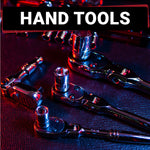The right bolt size prevents frustration, stripped fasteners, and wasted trips to the hardware store. We’ll walk you through simple methods to identify SAE and metric bolt sizes using tools most DIY mechanics already own. Follow these practical techniques to select the right sockets and wrenches and get the right fit every time.
Get the Right Measuring Tools
Accurate bolt measurements start with the proper tools. These basic measuring instruments make bolt identification simple and precise:
- Digital calipers provide the most accurate measurements for bolt diameter, length, and thread pitch. These precision tools provide exceptional accuracy and clearly display numbers.
- Bolt-size gauges offer a practical alternative to calipers. These metal or plastic cards contain different-sized holes labeled with their exact dimensions. Simply insert your bolt through the holes until you find the smallest one it fits through. The gauge separates metric from standard measurements for faster identification.
- Steel rulers work well for measuring bolt length. Look for rulers with metric and standard scales. For the most accurate length measurements, place the bolt directly against the ruler and read from the appropriate end based on the bolt type.
- Thread pitch gauges consist of small metal plates with different thread patterns. A thread gauge matches thread pitches for coarse-pitch threads and finer thread options.
- Combination wrenches or sockets in metric and standard sizes can be impromptu measuring tools. If a 10 mm tool fits on a bolt head, for example, you have an M6 bolt.
Olsa Tools offers precision measuring tools that DIY mechanics can trust for accurate bolt measurements.
Understand Bolt Anatomy
To measure a bolt, you need to know the names of its components. These are the bolt parts that you might want to measure:
- The head sits at the top of the bolt and comes in various shapes. The head style determines which socket size or bit you’ll need. Hex heads, the most common type, feature six sides for a wrench grip. Socket heads contain an internal recess for hex keys. Button, pan, and truss heads have distinct profiles that require specific tools.
- The shank (also called the body or shoulder) runs from beneath the head to where the threads begin. This unthreaded portion maintains stability in connections by preventing radial movement. Without a shank, bolts work loose under vibration or stress easier.
- The thread forms the helical ridge wrapped around the bolt's lower portion. Fully threaded bolts have threads running the entire length below the head, while partially threaded bolts maintain an unthreaded shank section.
- The major diameter measures the widest point across the threads. This thread diameter defines compatibility with bolt holes and clearance holes in assemblies.
- The minor diameter represents the narrowest point at the thread root. This measurement matters less for typical identification but affects the bolt's tensile strength.
- The tip forms the endpoint of the bolt. Most machine bolts feature flat tips, while wood bolts often have tapered ends.
How To Measure the Bolt Head
The bolt head measurement tells you which socket or wrench you need for a bolt. Here's how to get precise measurements.
For Hex Head Bolts
- Measure across the flats: Position your caliper or ruler on opposite parallel flat sides of the hex head (not the corners). This "across flats" measurement determines your wrench or socket size.
- Use a bolt gauge: Insert the bolt head into the gauge holes until you find the size that fits snugly. The labeled size indicates the correct wrench size.
For Socket Head Bolts
Place your caliper tips inside the hex recess and measure the distance between opposite flat sides. This tells you which hex key (Allen wrench) size you need.
For Other Head Types
- For torx: Measure across the widest points of the star pattern.
- For square: Measure across the flat sides of the square drive.
Note: bolt heads are often slightly smaller than their nominal size so tools can fit over them. For the most accurate results, test your measurement with the actual tool before applying significant force to avoid stripping the bolt head.
How To Measure Bolt Diameter
Bolt diameter measurements determine which nut or threaded hole fits your fastener correctly. The process works the same way for metric and standard bolts.
Measure the Major Diameter
Measure the distance from the outer thread on one side to the outer thread on the opposite side. This dimension, called the major diameter, typically defines the bolt size. Place your caliper or gauge across the widest part of the threads for the most accurate reading.
When you take this measurement, you'll get a specific value that directly corresponds to the bolt size:
- For metric bolts, the measurement in millimeters will match the M-size designation. For example, if you measure 8 mm across the threads, you have an M8 bolt.
- For standard bolts, the measurement in inches will match the fractional size. For instance, if you measure approximately a 1/2 inch across the threads, you have a 1/2-inch bolt.
Manufacturing tolerances mean your measurement might be slightly off from the exact nominal size. For example, a 1/2-inch bolt might measure 0.495-0.505 inches, but it's still classified as a 1/2-inch bolt.
Measure the Shank Diameter (alternative method)
For partially threaded bolts, you can also measure across the smooth, unthreaded shank. The shank diameter often matches the nominal bolt size. In some cases, the major diameter measures slightly larger than the shank due to the thread height.
Use a Bolt Gauge for Quick Checks
If you have a bolt gauge available, insert the bolt into progressively smaller holes until you find the smallest one it fits through. The labeled size indicates your bolt diameter.
For standard bolts smaller than 1/4 inch, manufacturers often use a number system instead of fractional inches. These range from #0 (0.060 inch) up to #14 (0.250 inch).
Olsa Tools' socket sets and wrench sets include both metric sizes and imperial measurements, so you always have the right tool for any bolt size.
How To Measure Bolt Length
Bolt length measurement methods differ based on the head type. The same approach works for metric and standard bolts, but you need to identify the head to take the right measurement.
For Protruding Head Bolts
Measure from the tip (bottom) of the bolt to where the shank meets the bottom of the head. The head height does not count as part of the length of these bolts.
For Countersunk Bolts
Measure from the top of the head to the bottom of the threaded portion. Countersunk bolts sit flush with the surface when installed. A carriage bolt, despite its dome-shaped head, uses this measurement because it must be countersunk. For these bolts, the head height counts as part of the total length.
How To Measure Thread
Metric and standard bolts have different thread patterns. This dimension determines whether nuts and bolts properly screw together.
For Metric Bolts: Thread Pitch
Thread pitch is the distance between adjacent thread peaks, measured in millimeters. Use calipers to measure from the peak of one thread to the peak of the next thread. For example, a common M10 bolt might have a 1.5 mm thread pitch, noted as "M10 x 1.5".
For Standard Bolts: Threads Per Inch (TPI)
Standard bolts use threads per inch instead of pitch. Count the number of thread peaks within a one-inch section of the bolt. No measurement tool is required; simply count the peaks. For example, a 1/2-inch bolt with 13 threads per inch would be noted as "1/2–13".
Thread Direction
Most bolts use right-hand threading, where the bolt tightens when turned clockwise. Left-hand threads also exist for specialized applications but are uncommon.
To determine the thread direction, look at the orientation of the pitch. If the pitch is low on the left and high on the right, you have a standard bolt that screws clockwise, and vice versa for counter-clockwise bolts.
About Bolt Size Notation
Bolt size notation provides a standardized format for identifying fasteners.
|
Metric bolt notation |
Standard bolt notation |
|
Metric format: M[diameter] x [pitch] x [length] mm Example: M10 x 1.5 x 50 mm
|
Standard format: [diameter]-[threads per inch] x [length] Example: 1/2-inch-13 x 3 inch
|
For bolts smaller than 1/4-inch, manufacturers use gauge numbers: #8–32 x 1 inch means a #8 diameter bolt with 32 threads per inch and 1-inch length.
Thread types include UNC (coarse), UNF (fine), and UNEF (extra fine) for standard fasteners. Metric fasteners use a simpler designation system where thread pitch is directly specified in millimeters, with standard coarse and fine options for each diameter (such as M10 × 1.5 for coarse or M10 × 1.25 for fine). When documents omit thread specifications, they typically refer to standard coarse threading.
Bolt Measurement Mistakes To Avoid
Misidentifying a bolt leads to wasted time, damaged threads, and incorrect fastener selection. These common mistakes cause inaccurate measurements and poor fits.
- Measure the major diameter across the thread peaks: A bolt’s size comes from its major diameter—the outermost edges of the threads. Precise bolt measurements prevent incorrect thread designation and mismatched screw threads in assemblies. Use calipers or a bolt gauge to check from thread peak to thread peak.
- Check thread pitch or threads per inch (TPI): Thread compatibility depends on pitch (metric) or TPI (standard). A bolt may fit into a nut but fail under load if the threads don’t match. A thread pitch gauge provides an exact match, preventing cross-threading or stripped fasteners.
- Measure length correctly: Bolt length runs from the bottom of the head to the tip, except for countersunk bolts. If you measure from the top of the head, you’ll get improper fitment. A ruler or calipers give an accurate reading when aligned properly.
- Use the right tools: A loose wrench or socket on a bolt head means the size is incorrect. A tape measure or eyeballing sizes leads to mistakes. Digital calipers, bolt gauges, and thread pitch tools give precise results.
- Avoid forcing a bolt into a gauge hole: If a bolt only screws in a little bit, it’s the wrong size. Forcing it damages the hole or the bolt. The correct hole allows the bolt to screw in smoothly.
Still have questions about how to measure a bolt or choose the right tools? Check out Olsa Tools' precision tools to take the guesswork out of fastener sizing.
Bolt Size Measurement FAQ
How do I figure out what size screw I need?
Measure the length from the tip to the bottom of the head. Check the major diameter across the threads. Match the thread pitch or threads per inch (TPI) to the receiving hole or nut. A caliper or thread gauge provides accurate measurements.
How do you shorten a bolt?
Mark the bolt where you want to cut it and place it in a vise. Use a cutting tool, like an angle grinder or a Dremel to cut the bolt. After cutting, run the tip at an angle against a grinder to remove the bur and taper the final thread.
Is M6 or M8 bigger?
M8 bolts have a larger diameter than M6 bolts. The number represents the major diameter in millimeters. An M6 bolt measures 6 mm across the threads, while an M8 bolt measures 8 mm.
Is M10 12 mm?
No, an M10 bolt has a 10 mm major diameter. The head size varies based on type, but standard hex head M10 bolts usually require a 17 mm wrench.
What is the difference between coarse-pitch threads and finer thread options?
Coarse threads have a larger gap between threads, which improves grip in softer materials and speeds up assembly. Finer thread options provide better resistance to vibration and higher tensile strength, making them ideal for heavy machinery and industrial machinery applications.
How do metric fasteners differ from imperial measurements in bolt sizing?
Metric fasteners use metric designation, where diameter in millimeters and thread pitch define the bolt. Imperial fasteners follow the thread designation of diameter and threads per inch (TPI). Always choose the right system so you don’t have mismatched fasteners in large-scale projects.
Why do some bolt holes need clearance holes?
Clearance holes are slightly larger than the thread diameter of a bolt, allowing it to pass through without engaging the threads. These holes help align parts in industrial machinery and prevent stress buildup in mechanical failures under extreme stress.
How does head size affect the type of nut I should use?
A larger head size spreads the load more evenly and prevents damage to softer materials. Some nuts, such as flange or lock nuts, require bolts with a specific head style to maintain proper tension, especially in heavy machinery exposed to vibration.
What are the common thread pitches for metric fasteners?
Metric fasteners follow standard common thread pitches based on size. For example, M6 bolts typically use a 1.0 mm pitch, while M10 bolts may have either a 1.5 mm coarse pitch thread or a 1.25 mm finer thread.








